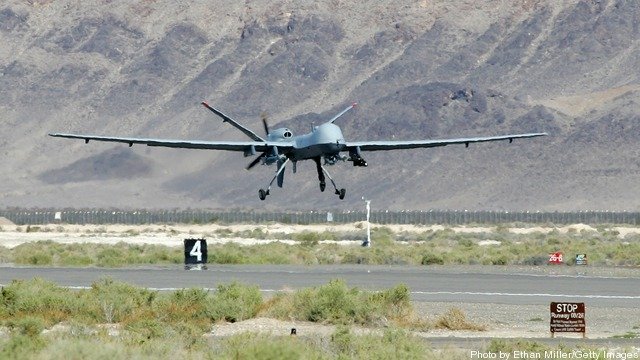@vstol Jockey @Falcon @Ashwin @BlackOpsIndia @Milspec @_Anonymous_ @randomradio @Sathya @Parthu @Volcano @Bali78 @Guynextdoor et al.
Guys you should see this. I found a graphical render of the proposed HAL/NewSpace Unmanned Wingman. I've resisted posting it so far because I assumed it was some fanboy stuff. But it was put out by a former IAF and now HAL test pilot. This guy is no uninformed fanboy. Here it is :
View attachment 7753
Weapons :
It seems to be armed with at least 4 DRDO Smart Anti-Airfield Weapon(SAAW). 2 internal & 2 external(1 not visible from this angle).
View attachment 7760
The internal payload will probably use a scaled down version of DRDO's single rack ejection system for SAAW which was designed to carry 4 SAAW instead of 2.
View attachment 7756
This is one of the graphic poster released by HAL/NewSpace during AeroIndia 2019 :
View attachment 7757
There is a discrepancy on that poster. The payload capacity is set at 250 kg. Each SAAW weighs 125 kg, so how can a drone with 250 kg payload capacity carry 4 of them ? Unless the 250 kg payload capacity given here is for internal carriage only, in which case it make sense.
Also the focus on carrying SAAW would seem to indicate an emphasis on SEAD/DEAD Ops. Not suprising given the dangers associated with these missions. Commanders would want to take humans out of these missions as much as possible, an stealthy well-networked UCAV is the way to go.
Engine :
Of course the weakest link in any of our air-breathing flying machine projects is the engine. So let's examine this closely.
The wingman in the graphic render seems to be powered by(as was previously reported) 2 HAL PTAE-7 turbojet engine(3.73 KN thrust). The HAL designed and manufactured PTAE-7 has been in continuous production since December 2000 and has proven to be a very reliable engine. In all these years of service the engine has never failed to deliver.
View attachment 7755
Initially designed for the Lakshya PTA, the engine has been chosen to power the under development Abhyas HEAT which is going to replace to British made Banshee target drone.
View attachment 7762
This is what ADE had to say about the PTAE-7's test flights in a document dated November 2006. Keep in mind these specs are dated and there has been significant improvement in the engines performance since it entered service. For example the weight of the engine today is about 65 kg instead of 69 kg which would obviously increase engine TWR.
View attachment 7754
Also the engine back in 2006 had and endurance of 20 max duration flights of the Lakshya PTA(30+ minutes). That has been increased significantly owing largely to breakthroughs in material research. Case in point the Abhyas HEAT has a max flight duration of 45+ minutes.
Each engine has a service life of more than (20x45)=900 min= 15 hrs. Even without any improvements we'd have the following numbers :
Targeted maximum flight duration for the HAL wingman= 80 minutes= (80/60)= 1.33 hrs.
Number of flights before needing an engine replacement= (15/1.33)= 11.27 flights ~11 flights
This is of course assuming there has been no improvements to the endurance cycles of the engine and that the drone flies maximum duration flights every time its launched. None of these assumptions are true and with proper maintenance practices the average number of flights before engine replacements can be pushed up further.
Also since the production line for the engine has been running since the early 2000s and given the service record of the engine I wouldn't be surprised if the ground staff are experienced with the ins and outs of the engine design, maintenance, replacement and if possible repairs. Experience of this kind would normally take years of training and operational usage to acquire. I am also not concerned about spares and services, tooling etc. as these things are always a concern with brand new production lines.
Now for the negatives. The MTOW of the wingman is targeted at 1,300 kg using two engines, the Lakshya PTA is approx 705 kg MTOW. Calculating overall TWR we have :
For Lakshya PTA : TWR= (3.73x1000)Newtons/(705x9.81)Newtons= 0.506
For HAL Unmanned wingman : TWR=(2x3.73x1000)Newtons/(1300x9.81)Newtons= 0.58496 ~ 0.585
A thrust to weight ratio of 0.585 is not that good really especially given the environment in which its meant to work. Needless to say it won't be dodging any SAMs or AAMs or at the right altitude even MANPADS. Incidents like the recent shoot down of the US drone by the Iranians might become our future. But for what its worth, it will have comparable maneuverability to an BAE Hawk. Quite the achievement !
There is of course the efficiency problem. The PTAE-7 is a turbojet, at subsonic speeds it will always be less efficient than a comparable turbofan. Problem is there is no comparable turbofan with us. The one that comes close is the Manik turbofan, but the Manik engine along with its auxiliaries will weigh around 130 kg each, which is twice the weight of the PTAE-7. There would be gain in thrust too(3.73 KN to 4.25KN) but it is not significant enough to justify such an increase in weight. The IAF after all, care more about TWR than efficiency.
View attachment 7778
On the other hand we came across this from January last year as Saurav Jha reported(
DRDO And NAL Collaborate On A New Small Turbojet For UCAV Applications | Delhi Defence Review) :
Small Gas Turbine Jet Engine (SGTJE) collaborative project by DRDO’s Research Centre Imarat (RCI), Hyderabad and the Propulsion Division of the National Aerospace Laboratories (NAL), Bengaluru.
"
detailed design of a turbojet engine of 275 kgf class as per RCI specification and development drawings for components and prototype engine for ground tests considering flight mounting, fuel flow control, pyro starting, alternator and QT/AT testing requirements in participation of RCI. Efforts are to be made by RCI/NAL to realize components for functional testing based on preliminary design to verify the design analysis before closure of the present project. Based on the functional testing & design analysis, prototype engine and components drawings are to be finalized for ground testing."
The broad parameters for the SGTJE are given below:
View attachment 7779
With the requirements specified above in mind, NAL’s Propulsion Division will assist RCI in the following:
"Detailed design of turbojet engine is to be carried out meeting RCI specifications and qualification/acceptance requirements for airborne engine start for UCAV applications. Based on the literature survey & engine cycle analysis, engine configuration will be arrived at, using centrifugal/mixed flow compressor and axial turbine. After configuring the engine, the components like compressor, combustor, turbine, nozzle, bearings & seals, and rotor dynamic design and analysis will be carried out to meet the design and
qualification requirements. Based on the components structural & CFD
analysis, design optimization & redesign will be carried out."
Interesting times ahead.
 Sensors :
Sensors :
There is a forward mounted radar which is most likely going to be a smaller lighter version of the UTTAM AESA radar. For some reason the render of the radar posted above reminded me of this :
View attachment 7761
Phase shifter array assembly of the Ragendra radar used in Akash SAM system.
For a drone this size it is disappointing to see no EO payload onboard this thing.







